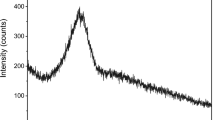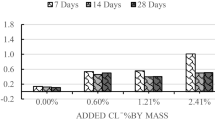Abstract
This paper investigated the hydration properties of steel slag under autoclaved condition (216 °C and 2 MPa). The results show that under autoclaved condition, besides C2S and C3S, f-CaO and the minerals containing MgO can react sufficiently. The morphologies of Ca(OH)2 produced by f-CaO are quite different from those produced by C2S and C3S. The Ca(OH)2 produced by f-CaO has a larger specific surface area or volume than that produced by C2S and C3S. The mean Ca–Si ratio of the C–S–H gel produced by steel slag is between 1.7 and 1.9, which is a little smaller than that produced by cement. The reaction of f-CaO tends to cause greater expansion than that of the minerals containing MgO.








Similar content being viewed by others
References
Shi CJ. Steel slag-its production, processing, characteristics, and cementitious properties. J Mater Civil Eng. 2004;16:230–6.
Kourounis S, Tsivilis S, Tsakiridis PE, Papadimitriou GD, Tsibouki Z. Properties and hydration of blended cements with steelmaking slag. Cem Concr Res. 2007;37(6):815–22.
Tsakiridis PE, Papadimitriou GD, Tsivilis S, Koroneos C. Utilization of steel slag for Portland cement clinker production. J Hazard Mater. 2008;152:805–11.
Liu SH, Li LH. Influence of fineness on the cementitious properties of steel slag. J Therm Anal Calorim. 2014;117:629–34.
Hu SG, Wang HX, Zhang GZ, Ding QJ. Bonding and abrasion resistance of geopolymeric repair material made with steel slag. Cem Concr Compos. 2008;30(3):239–44.
Zhang TS, Yu QJ, Wei JX, Li JX, Zhang PP. Preparation of high performance blended cements and reclamation of iron concentrate from basic oxygen furnace steel slag. Resour Conserv Recycl. 2011;56(1):48–55.
Zhang TS, Liu FT, Liu SQ, Zhou ZH, Cheng X. Factors influencing the properties of a steel slag composite cement. Adv Cem Res. 2008;20:145–50.
Wang Q, Yan PY, Yang JW. Influence of steel slag on mechanical properties and durability of concrete. Constr Build Mater. 2013;47(10):1414–20.
Wang Q, Yan PY, Han S. The influence of steel slag on the hydration of cement during the hydration process of complex binder. Sci China Technol Sci. 2011;54(2):388–94.
Zhu X, Hou HB, Huang XQ, Zhou M, Wang WX. Enhance hydration properties of steel slag using grinding aids by mechanochemical effect. Constr Build Mater. 2012;29:476–81.
Li JX, Yu QJ, Wei JX, Zhang TS. Structural characteristics and hydration kinetics of modified steel slag. Cem Concr Res. 2011;41:324–9.
Yan PY, Mi GD, Wang Q. A comparison of early hydration properties of cement–steel slag binder and cement–limestone powder binder. J Therm Anal Calorim. 2014;115(1):193–200.
Qian GR, Sun DD, Tay JH, Lai ZY, Xu GL. Autoclave properties of kirschsteinite-based steel slag. Cem Concr Res. 2002;32:1377–82.
Yazıcı H, Deniz E, Baradan B. The effect of autoclave pressure, temperature and duration time on mechanical properties of reactive powder concrete. Constr Build Mater. 2013;42:53–63.
Hossain KMA. Volcanic ash and pumice as cement additives: pozzolanic, alkali–silica reaction and autoclave expansion characteristics. Cem Concr Res. 2005;35:1141–4.
Saphouvong K, Saito T, Otsuki N, Yumoto T. Corrosion of steel bars in autoclaved concrete pile containing γ-2CaO·SiO2 with an accelerated carbonation curing submerged in the real marine environment. J Soc Mater Sci. 2012;61(3):299–307.
Li H, Zhao FQ, Li Q, Fu LL, Liu SJ. Autoclave brick from semi-dry desulfuration ash. Adv Mater Res. 2011;846:217–8.
Connan H, Ray A, Thomas P, Guerbois JP. Effect of autocalving temperature on calcium silicate-based building products containing clay-brick waste. J Therm Anal Calorim. 2012;88:115–9.
Qian GR, Sun DD, Tay JH, Lai ZY. Hydrothermal reaction and autoclave stability of Mg bearing RO phase in steel slag. Br Ceram Trans. 2002;101(4):159–64.
Zhang TS, Yu QJ, Wei JX, Li JX. Investigation on mechanical properties, durability and micro-structural development of steel slag blended cements. J Therm Anal Calorim. 2012;110:633–9.
Mindness S, Young JF. Concrete. New Jersey: Englewood Cliffs; 1981. p. 93–4.
Gao PW, Wu SX, Lu XL, Deng M, Lin PH, Wu ZR, Tang MS. Soundness evaluation of concrete with MgO. Constr Build Mater. 2007;21(1):132–8.
Ali MM, Mullick AK. Volume stabilization of high MgO cement: effect of curing conditions and fly ash addition. Cem Concr Res. 1998;28:1585–94.
Taylor R, Richardson IG, Brydson RMD. Composition and microstructure of 20-year-old ordinary cement-ground granulated blast-furnace slag blends containing 0 to 100% slag. Cem Concr Res. 2010;40:971–83.
Richardson IG. The nature of C–S–H in hardened cements. Cem Concr Res. 1999;29:1131–47.
Escalante-Garcia JI, Mendoza G, Sharp JH. Indirect determination of the Ca–Si ratio of the C–S–H gel in Portand cements. Cem Concr Res. 1999;29:1999–2003.
Gutteridge WA, Dalziel JA. Effect of a secondary component on the hydration of Portland cement, Part I: a fine non-hydraulic filler. Cem Concr Res. 1990;20:778–82.
Acknowledgements
Authors acknowledge the support from the State Key Laboratory of High Performance Civil Engineering Materials (2011CEM005) and Tsinghua University Initiative Scientific Research Program (20131089239).
Author information
Authors and Affiliations
Corresponding author
Rights and permissions
About this article
Cite this article
Wang, Q., Shi, M. & Zhang, Z. Hydration properties of steel slag under autoclaved condition. J Therm Anal Calorim 120, 1241–1248 (2015). https://doi.org/10.1007/s10973-015-4397-3
Received:
Accepted:
Published:
Issue Date:
DOI: https://doi.org/10.1007/s10973-015-4397-3




